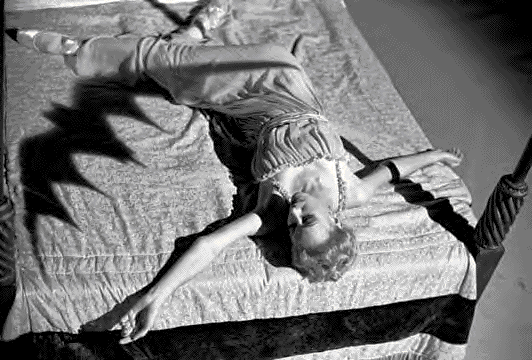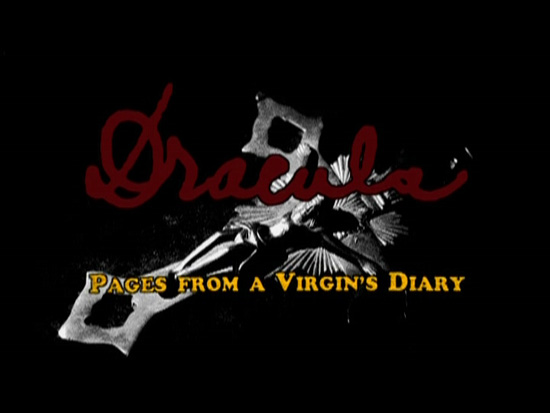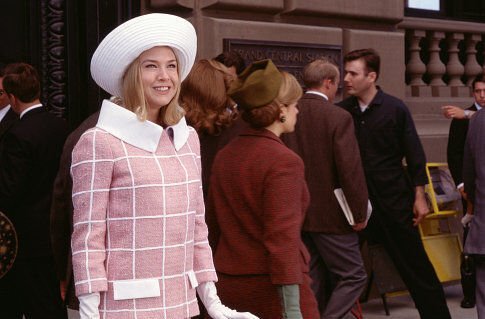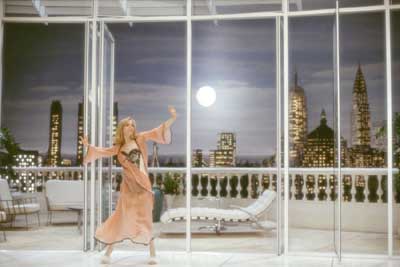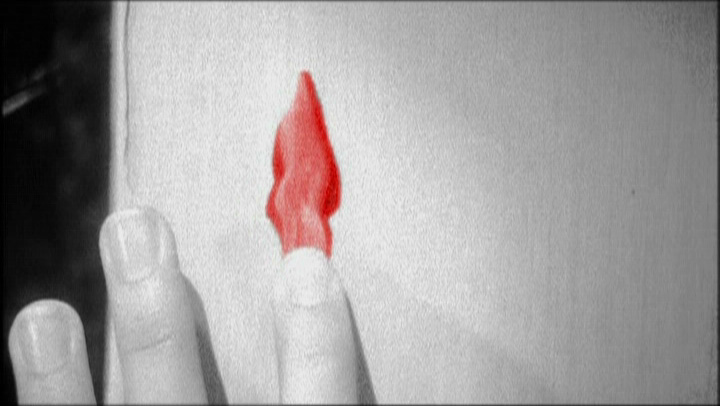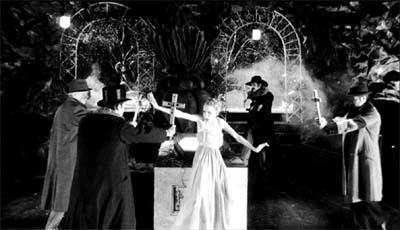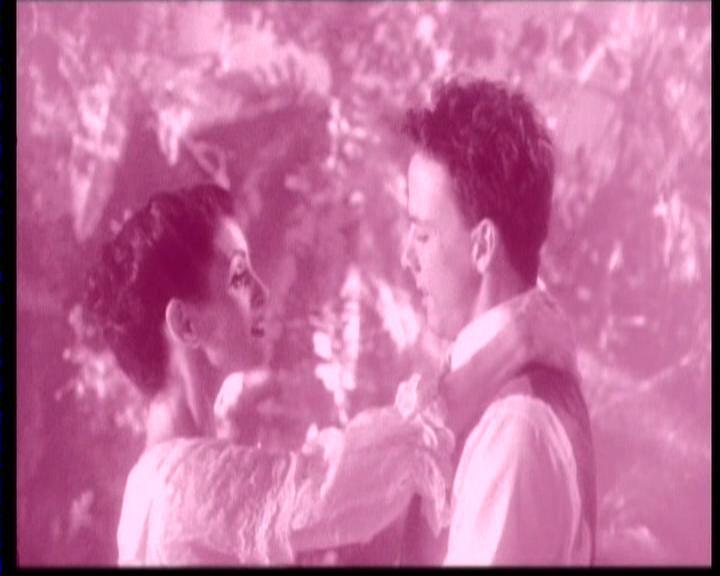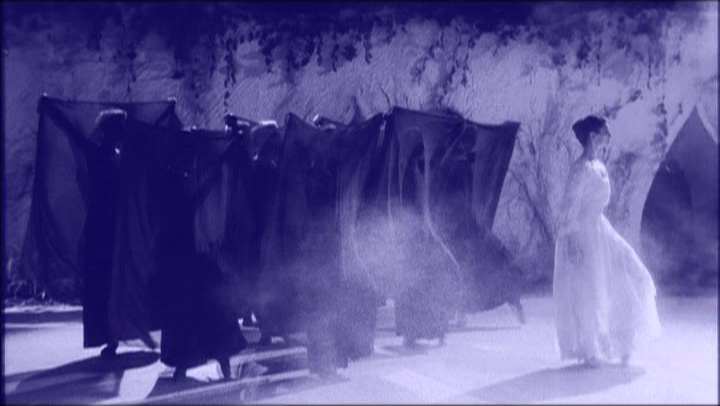I’ve appended a different title to this Chicago Reader review which ran on July 11, 2003 and restored a few details in my argument as well as phrases that a bleary-eyed editor, foregoing the Reader’s usual writer-friendly protocol, deleted at the last minute without telling me. Down with Love, in particular, continues to be a major revelation and source of pleasure for me. — J.R.
Down With Love
**** (Masterpiece)
Directed by Peyton Reed
Written by Eve Ahlert and Dennis Drake
With Renee Zellweger, Ewan McGregor, Sarah Paulson, David Hyde Pierce, and Tony Randall.
Dracula: Pages From a Virgin’s Diary
*** (A must-see)
Directed and written by Guy Maddin
With Zhang Wei-qiang, Tara Birtwhistle, David Moroni, CindyMarie Small, Johnny Wright, and Brent Neale.
If a more interesting and entertaining Hollywood movie than Down With Love has come along this year, I’ve missed it. Down With Love — which has already closed in Chicago — is entertaining thanks to Eve Ahlert and Dennis Drake’s clever script, Peyton Reed’s mainly assured direction, inventive production and costume design, a musical number behind the final credits I’d happily swap all of Chicago for, and even a miscast Renee Zellweger pulling off a difficult climactic monologue. But I was knocked out less by these achievements, which are clearly deliberate, than by the film’s authentic weirdness, which is apparently accidental.
One reason I took so long getting to see this movie was the number of friends who assured me it was nothing special. Most of them seemed to go along uncritically with the publicists’ claim, echoed by reviewers, that it was a simple point-by-point pastiche of three late-50s and early-60s comedies starring Rock Hudson, Doris Day, and Tony Randall: Pillow Talk (1959), Lover Come Back (1961), and Send Me No Flowers (1964). These films have never appealed to me in the slightest, though Mark Rappaport did an expert job of unpacking them in his 1992 Rock Hudson’s Home Movies, just out on DVD.
But Down With Love is also an affectionate satire of late-50s and early-60s studio glitz that often contradicts the pastiche. The filmmakers, who were too young to experience this era themselves, make plenty of errors, starting with a Fox CinemaScope logo (wrong studio and too late for that logo) and the snazzy rainbow credits (too hyperactive for the time). Then we get palatial Manhattan apartments (much more identified with How to Marry a Millionaire in 1953 and The Tender Trap in 1955) and bubble-gum-colored media blitzes (as in Funny Face and Will Success Spoil Rock Hunter?, both 1957), and culminating in the visual and verbal double entendres, anti-smoking gags, and overt references to feminism and homosexuality that are more identifiable with subsequent decades, all the way up to the present.
Furthermore, these subjective errors — coming from people too young to have encountered the period directly, characteristically collapsing and scrambling two decades into one, and therefore winding up with a hyperbolic dream of a dream —- made the movie more fascinating and touching rather than less. By expressing a yearning for what’s perceived (with debatable accuracy) as less cynical and more innocently romantic times, Down with Love has a lot to say about today. It also conveys an aching sense of absence that’s too definitive to qualify as nostalgia. Nostalgia tends to shrink our image of the past into cozy pocket-size dimensions, something we already know, but this movie expands that image temporally as well as spatially — suggesting that in some ways the past is more sophisticated than the present, even if we can’t say exactly how. It hovers ambiguously over a stupid and tacky trio of hypocritical comedies as if they contained awesome and precious secrets, and even though I can’t quite swallow that premise as film criticism, I treasure its creative and poetic insights into the present.
Our embrace of technology and planned obsolescence — which remains vital to the further enrichment of the wealthy — condemns us to a myth of continuous progress. Yet we remain haunted by the feeling that we’ve left something substantial and untapped behind. Historian Eric Hobsbawm recently suggested that people in the 19th century had an edge on us in their capacity to distinguish war from peace. Hollywood filmmakers in the supposedly repressive 1950s found more ways to work social criticism into their movies than their counterparts today can manage, and some film directors in the 1920s knew things about their craft and art that the Scorseses, Spielbergs, and Lucases — with all their high-tech equipment — can’t begin to fathom.
Winnipeg filmmaker Guy Maddin’s work testifies to the notion that the past knows more than the present and that silent cinema is a richer, dreamier, sexier, and more resonant medium than what we’re accustomed to seeing in the multiplexes. That may be why everyone I know who’s seen his Dracula: Pages From a Virgin’s Diary is crazy about it. There’s been a gratifying expansion of Maddin’s loyal band of followers ever since his seven-minute pastiche of silent Russian cinema, The Heart of the World, became a hit at the Toronto film festival two years ago, followed by its release along with his four previous features (Tales From the Gimli Hospital, Archangel, Careful, and Twilight of the Ice Nymphs) on two well- produced DVDs.
So Maddin, who will have another feature out later this year, is well on his way to becoming a household name like David Lynch. But if his Dracula, which opened last week at the Music Box, is reduced to its standard publicity labels — as Down With Love was — it could be shunned. A silent black-and-white film of a ballet based on Bram Stoker’s novel and performed to portions of Mahler’s first two symphonies — who could possibly want to see that? Warning signals are virtually programmed to go off in our heads when we hear terms like “silent,” “black-and-white,” and “ballet.” In addition, horror buffs might blanch at the thought of ballet and Mahler, while ballet and Mahler fans could be put off by the prospect of a vampire film.
All of these elements are present in Dracula — to a point. Discreet sound effects make the movie not quite silent. The selective use of color — red blood, green dollar bills (American not Canadian), yellow intertitles, a blue cross, a rainbow-tinged mist — makes it not quite black-and-white. And even though this is a film of a ballet, it isn’t in any usual way a ballet film. It would be more precise and telling to call Dracula simply a Guy Maddin movie, even though it’s a commissioned work. Maddin has admitted that his lack of interest in both ballet and Dracula made him hesitate before accepting the assignment and that part of what finally persuaded him was his need for money, the dollar bills he makes so much of. That this is thoroughly a Maddin movie in spite of everything is its major triumph. Its secondary triumph is that it peels away the usual associations we have with black-and-white and silent cinema, ballet, Mahler, and Dracula, making inspired use of all of them.
Maddin has also indicated that even though he was bored by the Stoker novel, he was intrigued by the elements involving male problems with sexuality — including jealousy, rivalry, and paranoia, especially in relation to race, nationality, and ethnicity. This is apparent at the outset of the film, when graphic images of blood spilling across Europe are accompanied by such intertitles as “East Coast of England 1897,” “Immigrants!” “Others!” “From Other Lands,” “From the East!” and “From the Sea!” Maddin makes this theme even more nuanced by having Dracula played by a Chinese-Canadian, Zhang Wei-qiang, who periodically evokes the late French-Italian New Wave actor Pierre Clementi. This reading of the novel may, as critic Mark Peranson has suggested, be more faithful than any other we’ve had to date. (Most adaptations derive from Deane and Balderstein’s play rather than the novel, and only Francis Coppola’s splashy and underrated 1992 Bram Stoker’s Dracula rivals Maddin’s as a meditation on the historical period.) That Maddin films his dancers in none of the conventional ways — often moving in for close shots and sometimes using as many jump cuts as Godard did in Breathless — doesn’t so much interfere with our appreciation of these dancers’ moves as reconfigure it, assigning it a fresh kind of poetics.
Would it be correct, then, to call Maddin’s works experimental? That’s what the National Society of Film Critics did when it awarded prizes for the year’s best experimental film to Archangel in 1991 and The Heart of the World in 2000. Maddin and NPR critic Pat Dowell have expressed some polite skepticism about the label. Having been part of the NSFC faction that lobbied for the prizes, I can say that we used that category because we knew it was the only way our organization could ever honor the films. Why? Because critics are just as hemmed in by packaging as publicists. It’s frustrating that we all go to movies in search of something new, but when it comes to defining newness in the mainstream marketplace the only acceptable ploy is to use old categories — thereby repudiating whatever is new and undefined. Simply put, the meager imaginations and resources of publicists and their mouthpieces, including critics, define the limits of what we’re directed to see.
Bearing this in mind, Maddin’s fans, like Maddin himself, might be seen as smugglers attempting to widen the possibilities of pleasure in movies whenever and however they can. Tapping the richness of 1920s filmmaking under the mask of irony (a principal tool of subterfuge in the present climate), Dracula offers a feast of rapid editing, fast lap dissolves, fade-outs, whiteouts, blackouts, tinting, superimpositions, irises, slurred motion, stop motion, and slow motion, along with the delectable textures of light, mist, snow, human flesh, vegetation, and Victorian upholstery. Yet it isn’t so bound by the technical parameters of 20s pictorial film art that it can’t make fruitful use of Super-8 footage and digital effects. That it’s principally in black and white and mainly silent makes it more expressive and sensual rather than less — a premise that may seem hard to swallow because we’ve been trained to fetishize state-of-the-art technology involving color and sound.
In fact, Maddin makes better use of digital effects than most Hollywood-blockbuster wizards, because he’s an artisan, not a factory worker — the mark of his hand is everywhere. And this only makes it easier for viewers to enter and get lost in his fantasy. A good indication of the kind of art he’s aiming for can be found in an appendix to Caelum Vatnsdal’s helpful and engaging book Kino Delirium: The Films of Guy Maddin (2000), in a text Maddin wrote titled “A Letter in Severe Terms Suggesting a Four-Point Manifesto for Better Movies.” Let me cite only the second point, devoted to actors:
“a) The studies of physiognomy and phrenology should be primary considerations in the casting of actors. Head bumps have long been ignored by the industry.
“b) Actors should have expressive fingers, real or artificial, for fingers represent up to ten more tongues, each capable of expressing a thought or a throb. The first finger — the tongue — should be used a lot less.
“c) Walking actors have forgotten how to walk. All actors should walk with latent or overt purpose, and cram a little poetry into their gaits while they’re at it.
“d) Sitting or lying-down actors should sit or lie down with poetry. Modern directors have garbed such actors in prose for at least five decades. How they have done this is a mystery, for the sitting and lying-down actors suggest anything but prose — dreams knit within their heads; looms vigorously producing dreamy tapestries fling their stray threads into the air above these heads; the stray threads fall at random onto the floor in children’s patterns of adult schemes, little primitive scraps of sordid wish fulfillment. The air and ground surrounding these actors should be strewn with mysteries, tangles, shreds, rent aromas, half-committed murders and doilies.
“e) Because of the above, the sleeping actor is the best actor — the poetically and psychologically truest representation of the human — and should be used as often as the sitting, lying-down, walking, running and flying actors.”
The neosurrealist flavor of these directives lets us know that Maddin is no foe of the industrial film studio and what it can produce. More precisely, he belongs in the tradition of such obsessional, poetic tale spinners and studio craftsmen as Erich von Stroheim, F.W. Murnau, Josef von Sternberg, Jacques Tourneur, and Michael Powell, who bend public materials towards private ends, taking us along for a feverish theme-park ride.
